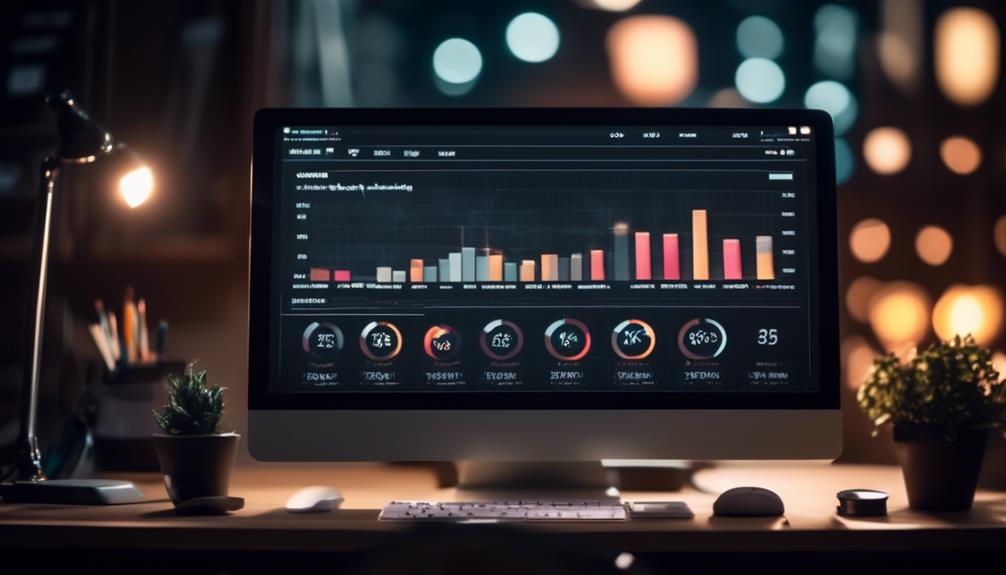You may not be aware that mastering email automation with the aid of a virtual assistant can significantly enhance your marketing efforts. Setting up automated processes and managing subscriber lists are just the tip of the iceberg when it comes to optimizing your email campaigns. However, there are seven key aspects you should consider to ensure your email automation strategy is effective and yields the desired results. From crafting personalized automated responses to troubleshooting potential issues, each aspect plays a crucial role in maximizing the potential of this powerful tool. Stay tuned to uncover the essential elements that will elevate your email marketing game.
Setting Up Automation
To efficiently set up automation for your email processes, start by outlining the specific tasks that can benefit from automation. Workflow organization plays a crucial role in streamlining your email operations. Identify repetitive tasks such as sending welcome emails, follow-ups, or newsletters that can be automated to save time and increase efficiency. By automating these processes, you free up valuable time to focus on more strategic aspects of your email marketing campaigns.
Content personalization is another key benefit of email automation. Segmenting your audience based on their preferences, behavior, or demographics allows you to tailor your messages to resonate with each group. Automation tools enable you to send personalized content to different segments simultaneously, enhancing engagement and conversion rates. Audience segmentation also ensures that the right message reaches the right people at the right time, maximizing the impact of your email campaigns. By incorporating these strategies into your automation setup, you can optimize your email processes for better results.
Managing Subscriber Lists
When managing your subscriber lists, organizing your contacts efficiently is key to effective email communication and targeted marketing. List segmentation is a powerful strategy that allows you to categorize subscribers based on preferences, behaviors, or demographics. By segmenting your list, you can send more personalized and relevant content, increasing engagement and conversion rates.
To enhance subscriber engagement, consider implementing engagement strategies such as sending tailored content based on subscriber interactions or creating targeted email campaigns for different segments. This approach can lead to higher open rates, click-through rates, and ultimately, improved ROI.
In addition to engagement strategies, focusing on growth tactics is essential for expanding your subscriber base. Encourage sign-ups through incentives, optimize your website for email captures, and leverage social media to attract new subscribers.
Moreover, maintaining list hygiene is crucial to ensure that your subscriber lists are up-to-date and free of inactive or invalid contacts. Regularly clean your lists by removing inactive subscribers and updating contact information to enhance deliverability and engagement. By effectively managing your subscriber lists, you can optimize your email marketing efforts and achieve better results.
Crafting Automated Responses
Segmenting your subscriber lists effectively not only improves engagement but also sets the stage for crafting automated responses that enhance your email marketing strategy. When crafting automated responses, focus on personalization. Start by using personalized greetings to create a more intimate connection with your subscribers. This simple touch can significantly increase the effectiveness of your automated emails.
Efficient scheduling is another key aspect to consider when crafting automated responses. Make sure your emails are sent at the optimal times to reach your audience when they are most likely to engage. Utilize data and analytics to determine the best times to schedule your automated emails for maximum impact.
Tracking Performance
Now, let’s talk about tracking performance. Analyze your click-through rates, monitor your open rates, and assess your conversion rates. These metrics will give you valuable insights into the effectiveness of your email campaigns.
Click-Through Rate Analysis
To effectively measure the performance of your email campaigns, analyzing the click-through rate is crucial for understanding engagement levels and optimizing future strategies. The click-through rate indicates the percentage of recipients who clicked on a link within your email. By tracking this metric, you gain insights into what resonates with your target audience and helps gauge the relevance of your content. A high click-through rate signifies that your emails are compelling and that your audience finds value in the content you provide. On the other hand, a low rate may indicate a need to adjust your content strategy to better align with the interests of your subscribers. Regularly monitoring and analyzing click-through rates empowers you to refine your email marketing approach effectively.
Open Rate Monitoring
Monitoring your email open rates provides valuable insights into the effectiveness of your email subject lines and overall campaign performance. By keeping a close eye on how many recipients actually open your emails, you can refine your strategies for better engagement. Here are some key points to consider:
- Subject Line Strategies: Experiment with different subject lines to see which ones drive higher open rates.
- A/B Testing: Test variations of your subject lines to determine the most effective ones.
- Personalization Techniques and Segmentation Strategies: Tailor your emails to specific audience segments for increased relevance and higher open rates.
Conversion Rate Assessment
After closely monitoring your email open rates and refining your strategies for better engagement, the next step is assessing your conversion rates to track the performance of your email campaigns. By implementing A/B testing strategies, you can compare different elements such as subject lines, call-to-action buttons, or content layout to see what resonates best with your audience. Customer segmentation allows you to tailor your emails based on specific demographics or behavior, increasing the relevance of your messages. Utilizing email personalization tactics and engagement strategies can further enhance your conversion rates by creating a more personalized and interactive experience for your recipients. Keep analyzing your conversion rates regularly to identify trends, optimize your campaigns, and ultimately drive more conversions.
Software Options
When it comes to choosing software for email automation and virtual assistant integration, you have a range of top tools available to consider. These tools offer customization features that can be tailored to your specific needs and preferences. Exploring these options can help streamline your workflow and boost productivity efficiently.
Top Email Automation Tools
To effectively streamline your email marketing processes, you should consider utilizing top email automation tools that can enhance efficiency and engagement with your audience. When looking for the right tool, it’s essential to consider factors such as automation efficiency and tool comparison. Here are three top email automation tools to consider:
- Mailchimp: Known for its user-friendly interface and extensive features.
- ActiveCampaign: Offers advanced automation options and in-depth analytics.
- HubSpot: Provides a comprehensive marketing platform with powerful automation capabilities.
Virtual Assistant Integration
As you explore optimizing your email marketing efforts with top automation tools like Mailchimp, ActiveCampaign, and HubSpot, the next step lies in considering Virtual Assistant Integration through various software options. Virtual assistant training and integration can significantly enhance your email automation processes by delegating tasks, streamlining workflows, and improving overall efficiency. By incorporating virtual assistants into your email automation system, you can leverage their capabilities to handle repetitive tasks, personalize customer interactions, and analyze data to enhance campaign performance. While the benefits of virtual assistant integration are clear, challenges may arise in ensuring seamless communication, providing adequate training, and maintaining data security. Selecting the right software options that facilitate virtual assistant integration is crucial for maximizing the potential of your email automation strategy.
Customization Features Available
Explore the diverse range of customization features offered by leading software options to elevate your email automation strategies and enhance user engagement. When considering personalization options and segmentation strategies, it’s crucial to choose a platform that aligns with your specific needs. Here are key customization features to look out for:
- Dynamic Content Creation: Tailor emails based on subscriber behavior and preferences.
- Advanced Segmentation Capabilities: Divide your audience into targeted groups for more personalized communication.
- A/B Testing Functionality: Experiment with different email elements to optimize engagement and conversion rates.
Troubleshooting
When encountering issues with email automation or your virtual assistant, the key to effective troubleshooting lies in a systematic approach to identify and resolve the root cause efficiently. Troubleshooting strategies play a crucial role in addressing common issues that may arise. Start by isolating the problem – whether it’s emails not sending correctly or your virtual assistant misunderstanding commands. Once identified, delve into troubleshooting best practices. These include checking for software updates, ensuring proper integration settings, and reviewing any recent changes made to the system. Utilize troubleshooting tools provided by your email automation or virtual assistant platform, such as diagnostic tests or logs, to pinpoint the exact issue. By following a structured troubleshooting process, you can swiftly tackle challenges and optimize the performance of your email automation and virtual assistant systems. Remember, patience and persistence are key when troubleshooting, and don’t hesitate to seek additional support from customer service if needed.
Optimizing Email Send Times
To enhance the effectiveness of your email campaigns, consider strategically timing the delivery of your emails to maximize engagement and response rates. When optimizing email send times, it’s crucial to experiment with different strategies and analyze the results to determine the most effective approach. Here are some key tactics to consider:
- A/B Testing Strategies: Conduct A/B tests by sending the same email to different segments of your audience at various times. Analyze open rates, click-through rates, and conversion rates to identify the optimal send times.
- Segmentation Techniques: Divide your email list into segments based on factors like demographics, behavior, or location. Tailor your send times to each segment’s preferences and habits to increase engagement.
- Personalization Methods: Use personalization to make your emails more relevant to each recipient. Leverage data on when individual subscribers are most active to send emails at times when they are likely to be checking their inbox.
Frequently Asked Questions
How Can I Personalize Automated Emails to Make Them More Engaging and Relevant to My Subscribers?
Want to make your automated emails pop? Personalize them! Use names, past purchases, or behavior data. Engage with catchy subject lines, creative content, and interactive elements. Keep it relevant and watch your subscribers click!
What Are Some Best Practices for Maintaining a Clean and Up-To-Date Subscriber List?
To maintain a clean and up-to-date subscriber list, regularly clean out inactive contacts, segment your list for targeted campaigns, monitor email deliverability, and analyze unsubscribe rates. Engage subscribers with relevant content to boost subscriber engagement.
How Can I Ensure That My Automated Responses Are Consistent With My Brand Voice and Messaging?
To ensure your automated responses match your brand voice and tone, craft templates that reflect your style guidelines. Personalize messages for better engagement. Consistency in messaging is key—imagine your brand as a character with a distinct personality.
What Key Performance Indicators Should I Be Tracking to Measure the Success of My Email Automation Campaigns?
To measure the success of your email automation campaigns, focus on tracking conversion rates and engagement metrics. Implement A/B testing and segmentation strategies to optimize performance. These key indicators will help you gauge effectiveness and refine your approach.
How Do I Choose the Right Email Automation Software for My Business Needs and Budget?
You need an email automation software that fits your business needs and budget. Look for features like email segmentation, customization, and integration for efficiency. Find a solution that streamlines your processes and maximizes your ROI.



